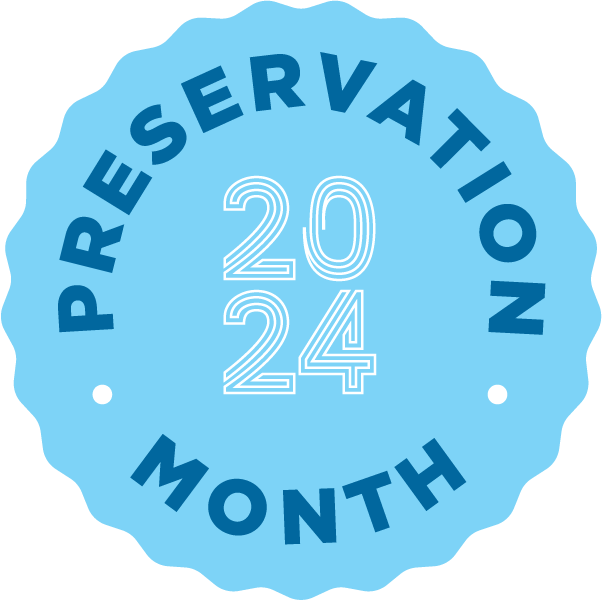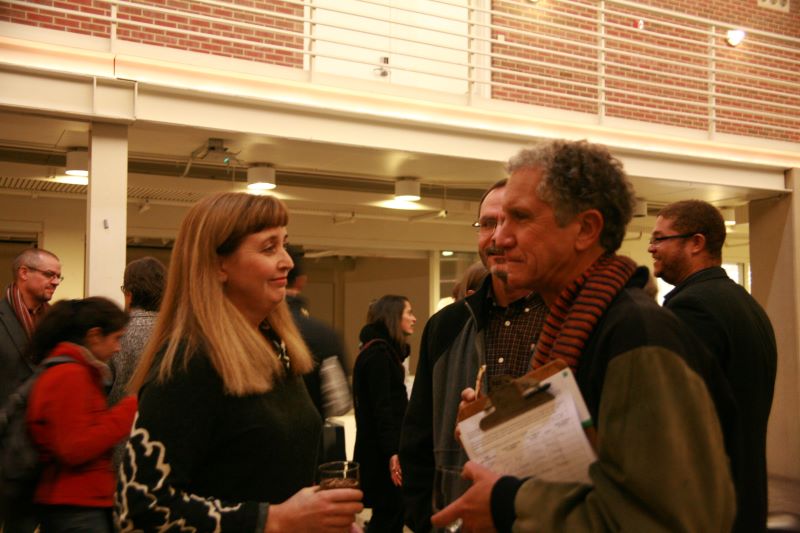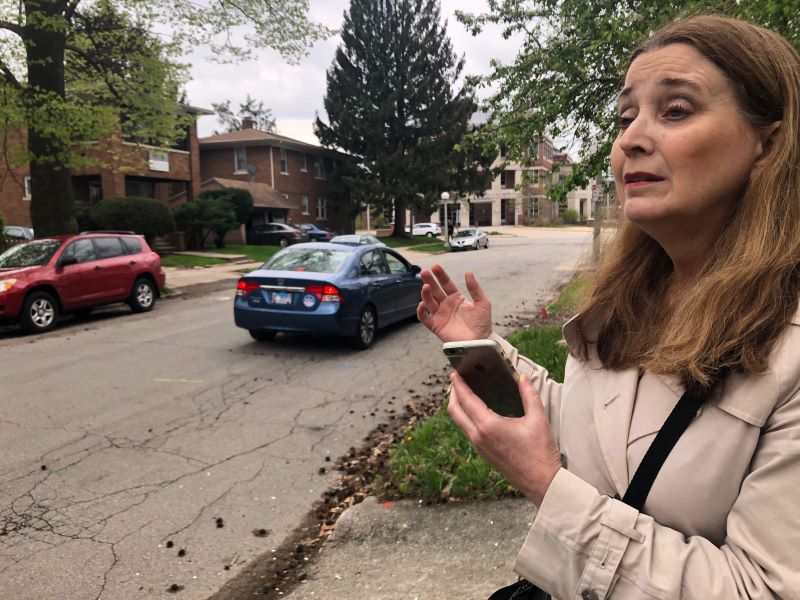May is Preservation Month and the National Trust for Historic Preservation (NTHP) has set a theme of “People Saving Places.” NTHP hopes “to shine the spotlight on everyone doing the work of saving places—in big ways and small.”
Keeping this theme in mind, I had a chance to sit down with Alice Novak, a local community member who has provided decades of service saving places in the Champaign County community and beyond. Here are a few pieces from that conversation. Alice touches on some of the work she’s completed over the years working to save some of Champaign County’s historic places and offers advice to those looking to save our area’s places in the future.

Pat: For those who don’t know you, would you mind telling us a little about yourself and your work in historic preservation?
Alice: I’ve been in preservation for over 30 years. I have a Masters of Urban Planning degree. I had a concentration with Lachlan Blair. It was a good combination of city planning and preservation stuff, which appealed to me. Lach Blair’s wife is 84 and still lives in their house on 506 West Illinois Street. I also worked for the Ohio Historic Preservation Office for about 3 years and it was part of the Ohio Historical Society. We were actually a not-for-profit arm instead of a regular organization. After a few years there, I came back here to work with Professor Blair who had started a consulting firm of professionals who had retired, but still wanted to keep their toes wet. It was mainly just Lach and me. I came here when Lach was here and I’ve been here ever since. I don’t know, maybe 1989 or something like that. I continued with consulting for a while on my own when Lach was just not able to compete with other firms.
Then, I started doing adjunct teaching for a while. As I was cutting back on Urbana group projects and consulting, I increased what I was doing with the University. I ended up teaching historic preservation courses for 22 years at the U of I.
I turned into a preservationist on a volunteer basis as well, including being on the board of PACA (Preservation and Conservation Association) for several years. Recently, I was honored by the City of Urbana and also saw a number of my students, at the Historic Preservation Commission’s regular meeting, which was really, very cool. For my 30 years of service to the City and that I created the Preservation Commission and was the first and only chair up until last week. Not that I was hogging it or anything... I was so glad I didn’t cry. They are all such nice people and I am so glad I’ve gotten to know them. And seeing the students, I was just honored by the whole thing. And cake, they had cake there too. Schnucks Cake. It was the best.
P: Why work in the historic preservation world? What motivated you to get involved with the field and sustain a long career within it?
A: If you’re the underdog, you fight harder. I didn’t care for planning on its own that much, but when you throw in the mix of zoning issues, other parts of urban planning, and the planning part of historic preservation, it makes planning itself more interesting. I enjoyed some of the battles we got into. Our attorneys would come present for their clients, their misguided clients, and really earn their commission.
When I see some of my students today, they just really want to make a difference and make things better. Early on, one of the best things for us was a house that fell under our ordinance for demolition delay rules. We had to wait to apply for the house as a landmark until it went through the process for that. So they can’t just go in and tear it down when it’s a building of a certain age and if the owner consents or not. There’s the house, 508 West Elm Street, that we were trying to save and it doesn’t look that great from the outside because it has aluminum siding and things like that that normally you wouldn’t want to see on a local landmark, but the inside is so gorgeous and it doesn’t come under the purview of the commission to go inside to look at the things, but it helps in the preservation effort in terms of people turning up for meetings and things when they see buildings and interiors. We had students helping and it was exciting. The students were really into it. It made a difference when you could say that the owner objected and was not going to move on with projects and you’re like “Yay!” Several students said they changed their degree to be in line with things like historic preservation after that. The fact that we saved that building way, way back and we all chipped in and did different parts of the project had an influence.

P: Do you have a particular project that was your favorite to work on? Why?
A: Yes, the saving of The Orpheum Theatre. That sticks out because that’s the perfect example of not only judging a building from the outside, but also seeing the inside. It was built in 1914 and it had been used mostly as a theatre. First off, from the process, I met some people that have ended up being lifelong friends and that’s great because that’s just great context to have for friendships and there were just some funny things that really upset the then mayor. We did lots of protests and it fell into place.
It started out as a children’s museum, which probably wasn’t a good thing to do, but it at least bought us some time to improve what we were going to do with the building. The building had artificial siding on it and the Orpheum just looked like a little shoebox kind of thing. There really wasn’t much decorative that was left. We pulled off the aluminum siding and recycled that and suddenly the building was exposed and you could see the architectural detail and such. That made it eligible to the National Register based on the research and that. There were kind of some technical questions and things. The National Register has a rule, and it’s enforced in Illinois pretty strictly, it’s not eligible if there’s aluminum siding on a building. We sneakily did the peeling off of the aluminum to look at the exposed things. Then, a colleague of mine and I wrote an application to the National Register without telling anyone there. They loved this sort of thing, it’s the blood in my veins I guess. It was a long-drawn-out process, but it was unanimously recommended to the National Register and subsequently fully listed after that.
It’s been particularly fun in Urbana because everybody works together. We’ve had great people on all sides, not-for-profits, the commission, and the City with its staff. Very rewarding, everyone chips in, everyone makes a difference. The sweetest part of what we do is everybody gets a piece of the action. Everybody gets to participate and it’s the only way to get things done to really build community.

P: For any young people looking to get involved with preservation, what advice would you offer?
A: First, try to do some volunteering, depending on what your day job is, do some volunteering to get to see how people move around to these meetings, and what kind of backgrounds they have, before you go to a PACA meeting, for example. I’m just basing it on what I did originally. If you can help out in any extra way, write an article, all these things just make such a huge difference. It’s so hard to find people to serve on boards.
It’s fun and it’s interesting. A lot of my students would get a kick out of the research by just looking at a few documents. So I love that. Obviously, I think, we’d have to have a change in how preservation operates nationally and I think students became more interested in that. There are so many different directions they can go with what we do. Even political stuff and not-for-profit work. I recommend students look at things that pair up nicely with something they’re already studying
P: To you, why is it important to save places? In particular, what do you find special about places in Champaign County?
A: Seeing is believing, especially with a lot of things we do in preservation. I know when the Burnham Mansion was being torn down, that should’ve never happened. I had my own little boycott of Champaign at that point, I wouldn’t drive through Champaign in the downtown. If you can see it to believe it, I think that’s not a bad thing. Unfortunately, there’s been a lot that’s been compromised in Champaign.
Looking at more positive things and places around here, I’ve always been a sap for the Assembly Hall. Max Abramovitz, kudos to Max. Some fraternities and sororities. I’m sorry about how we lost the cohesiveness of Washington Park. The theatres I think. The fact that we have five theatres. Urbana has the Buena Vista Court.
In Champaign, I can’t really list anything as I’m mad forever. It just lingers that something of international significance and an early work of Daniel Burnham is now just a parking lot. Seeing places still present has a huge influence on preservation.
P: Any other parting words you’d like to include in the article?
A: There are a lot of stereotypes people have with the community, Urbana in particular. But it’s a much more charming place and the people who live there, including myself, nothing compares to how it feels. With the gardening, a great sense of place, and more. I wish more people who didn’t necessarily have involvement with the University could come join us and move in. We’d have even more variety than what we have now.
Thank you to Alice for speaking with me and for all of her work in saving places throughout Champaign County.
Know anyone working hard to save places in your community? Share a message of gratitude with anyone you know working to save places this Preservation Month 2024!
-Pat Cain
Archives Manager
